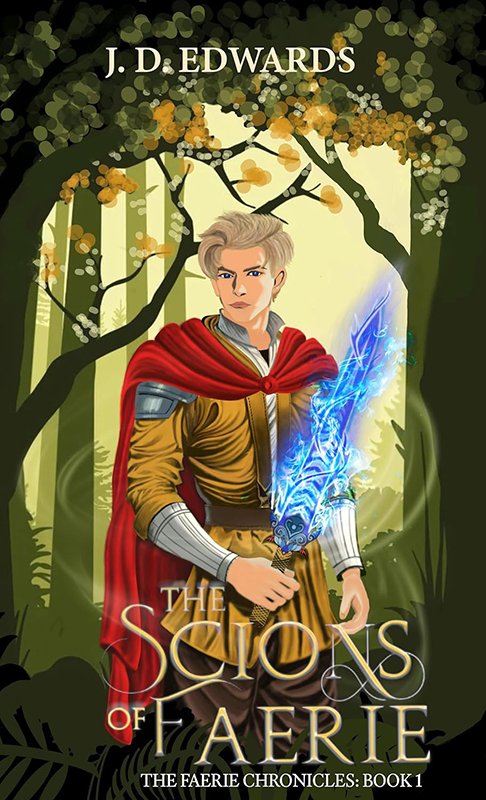PHOTO: J. D. Edwards, award-winning author, theologian, and genealogist, reflects on the journey behind his beloved Faerie Chronicles and bestselling historical novels.
Award-Winning Author Blends Magic, Memory, And Meaning
J. D. Edwards shares the personal stories and meticulous research behind his epic fantasy and historical fiction, offering readers a powerful blend of myth, loss, and literary craftsmanship.
J . D. Edwards stands as a beacon of creative brilliance in the world of literature, crafting stories that traverse the realms of Epic Fantasy, Historical Fiction, Horror, Theology, and Poetry with unparalleled mastery. A gifted storyteller with a theologian’s depth, Edwards possesses the rare ability to breathe life into ancient legends while weaving intensely human narratives of hope, grief, and redemption. His works offer readers not just an escape but a transformative experience, leaving one to linger in introspection long after the final page has been turned.
With accolades from prestigious organisations such as The Charl Ormond Williams Foundation, Carolina Bards, and TCK Publishing, Edwards has carved out an indelible space for himself in both historical research and speculative fiction. His historical novel Indomitable: The Story of Eliza Harris, an Amazon Top 10 Bestseller, exemplifies his painstaking attention to detail, marrying historical fact with the emotional resonance of personal struggle. Meanwhile, his epic fantasy series, The Faerie Chronicles, immerses readers in a richly constructed world, where Celtic myth meets modern landscapes, and every name and place brims with meaning.
Edwards’ ability to straddle narrative genres showcases his extraordinary versatility and boundless creative energy, whether he’s illuminating the dark corners of history or building fantastical worlds steeped in biblical prophecy and Celtic lore. His latest release, The Scions of Faerie, sets the foundation for yet another sweeping, multi-layered saga—one that invites readers to journey into lands where the boundaries blur between myth and reality, geography and imagination.
In this exclusive interview, J. D. Edwards opens up about his creative drive, his commitment to emotional authenticity, and the meticulous research process that both enriches his historical novels and breathes life into his fantastical realms. Whether delving into grief, identity, or the cost of magic, Edwards’ characters embody journeys that unerringly reflect the truths of human experience. As readers of The Faerie Chronicles and Indomitable will attest, every story from his pen is a testament to the transformative power of words—and to the enduring legacy of a masterful storyteller at work.
Edwards crafts unforgettable worlds with emotional depth, spiritual insight, and historical precision, inviting readers into stories that linger long after the final page.
In The Scions of Faerie, Ian’s journey intertwines Celtic mythology with modern settings – what inspired that fusion, and how did you research the ancient lore?
In 2003, my wife and I discovered we were expecting again, after the heartbreaking loss of our first son, Jonathan Ian Edwards. That moment marked the genesis of The Faerie Chronicles. I set out to write an epic fantasy that would blur the line between fiction and reality—where myths breathe, allegory hides in plain sight, and every shadow hints at a deeper truth.
I knew I wanted to breathe new life into ancient legends. I wasn’t interested in imitation or trope. I wanted to blur the lines between fantasy and reality so seamlessly that readers would begin to question where one ended and the other began.
“I wanted to blur the lines between fantasy and reality so seamlessly that readers would question where one ended and the other began.” – J. D. Edwards
To avoid mirroring contemporary interpretations, I turned to texts from the 18th and 19th centuries. These sources felt raw, elemental, and closer to the original telling. That decision allowed me to rediscover Celtic mythology with fresh eyes and weave it into the present day without compromising its mystery.
The Soul Stones of Faerie deepens your faerie world; how did you decide which mythical elements to expand or reinterpret?
In the foreword to The Lord of the Rings, J. R. R. Tolkien writes, “The story grew in the telling.” That line resonated within my soul. When I wrote The Soul Stones of Faerie, I compiled a loose collection of plot points and mythical elements in Microsoft OneNote. I didn’t treat them as a strict roadmap, but rather as inspiration that could evolve as the story unfolded.
I never knew how the story would end until I reached the final page, and I used the same strategy for the other books in the series. This freedom allowed the narrative to take on a life of its own—one in which I could lose myself completely. It’s that same sense of wonder and discovery that draws readers into Faerie, helps them connect with the characters, and allows the magic to take root within their hearts.
“The story grew in the telling.” – J. D. Edwards
Your Faerie Chronicles shift in tone across the series; how did you balance YA adventure with deeper themes like loss and identity?
You cannot have light without shadow. As the series progresses, it embraces more adult themes—loss, death, and betrayal—but I counterbalance those with moments of love, redemption, and cheeky humour. The Faerie Chronicles is a coming-of-age epic that invites readers of all ages to confront hard questions at their own pace and in their own way.
Much like Star Trek, these books explore difficult social and emotional terrain through the lens of an imagined world. That distance gives readers room to wrestle with reality while never losing the thrill of wonder, magic, and possibility.
With Indomitable, you moved into historical fiction—how did your genealogical writing influence your portrayal of real life characters?
I began researching my ancestry in 1989, and in 2012, while tracing my family’s ties to the Underground Railroad, I stumbled upon a manuscript interviewing my distant cousin, Reverend John Rankin. In it, he recounted his role in helping a young runaway slave named Eliza Harris; an account that would shape everything to follow. That discovery pulled me deep into the rabbit hole. I spent the next decade hunting for any shred of evidence that might reveal the path Eliza traveled, the stations she stopped at, and the people who risked everything to help her.
“You cannot have light without shadow.” – J. D. Edwards
Indomitable emerged from that journey. The only fiction in the novel lies in how I connect Fact A to Fact B, always using historical records and logical inference as my guide. The hardback special edition even includes an appendix that separates fact from fiction. And the war stories told by George Edwards? Those are drawn from his own words, just as he described them.
Given your success across fantasy, sci fi and historical genres, how do you choose which genre best suits a new story idea?
Because I have ADHD, my mind is constantly jumping between ideas and interests. Rather than fight that rhythm, I’ve learned to embrace it. I usually keep several manuscripts going at once and let instinct guide me toward whichever story has the strongest pull.
Right now, I’m halfway through writing The Defender of Faerie, a prequel to The Scions of Faerie. I’ve also started The Dark Realms of Faerie, which launches a new series, and I’ve revisited Dauntless, a historical fiction project I began in 2016. At any given time, it’s not the genre that leads, but the heartbeat of the story. I write whichever one calls loudest that day.
Many of your protagonists undergo personal grief—how do you weave authentic emotional arcs while keeping plot momentum?
Everyone faces grief at some point; some more than others. It’s not the pain itself that defines us, but how we respond to it. When tested by fire, do we become stronger, or do we shatter in the kiln of life?
That question is central to my novels. In 2004, after reading an early draft, George R. R. Martin told me: “Never create a character you’re unwilling to kill.” I’ve never forgotten his wise words. They’ve guided my storytelling ever since, reminding me that emotional honesty and plot momentum are not at odds. The loss has to matter. When it does, the reader feels it, and the story moves not just forward, but deeper.
Your background includes award winning genealogical research—how does that rigorous detail enrich your world building in speculative fiction?
My research is laborious, to say the least. While writing Indomitable, I tracked the phases of the moon to determine how much light Eliza Harris would have had as she made her way through the wilderness. I verified that every object, from a revolver to birthing techniques, matched the historical realities of the time.
It took longer to research the historical accuracy of Indomitable than it did to write the book itself. Whether I’m crafting historical or speculative fiction, the process is the same. I want every moment to feel lived-in and real, grounded in truth even when wrapped in fiction. That’s how my stories come alive.
What one piece of advice would you give aspiring authors based on your journey through multiple genres and publishing formats?
Expect your first draft to be rubbish, but don’t give up. Finishing the novel is the most important step. Everything after that is editing, refining, and reshaping. Sometimes, that means a complete rewrite.
I rewrote The Scions of Faerie four times before it was ready for publication. Indomitable only needed one full draft, but by then, I was a 20-year veteran. Even so, I rewrote the first few chapters several times, exploring different points of view until I found one that resonated. That version finally gave Eliza Harris a voice—the one that had been taken from her nearly 180 years ago.
EDITOR’S CHOICE
An enchanting masterpiece blending Celtic mythology, rich storytelling, and high-stakes adventure. Captivating, thrilling, and deeply resonant—perfect for fantasy lovers!



